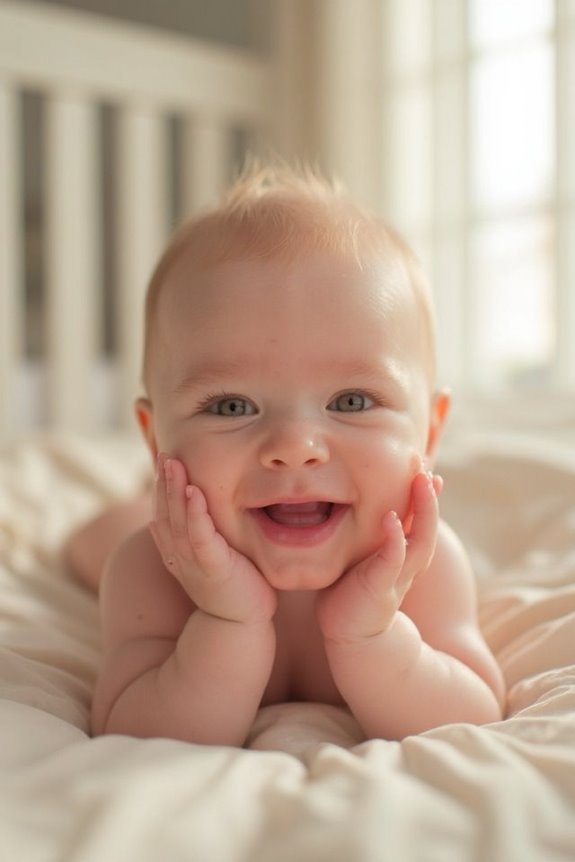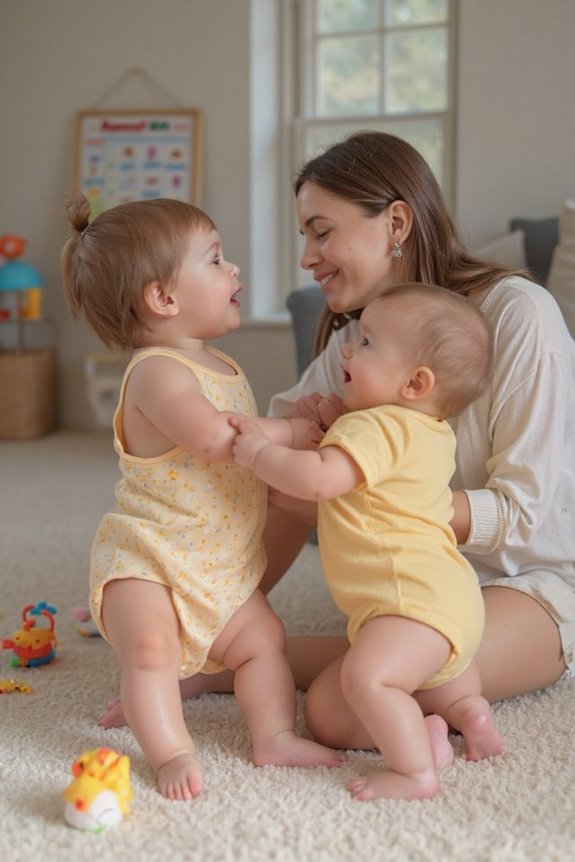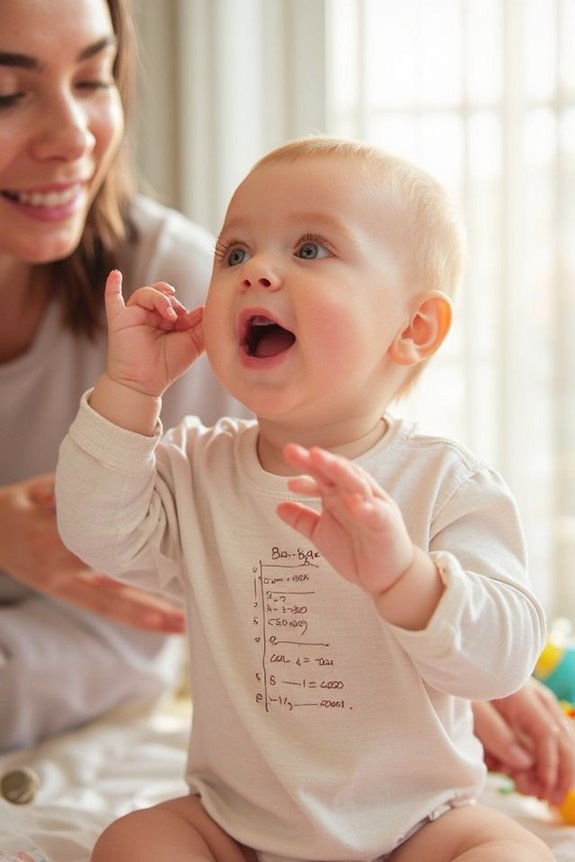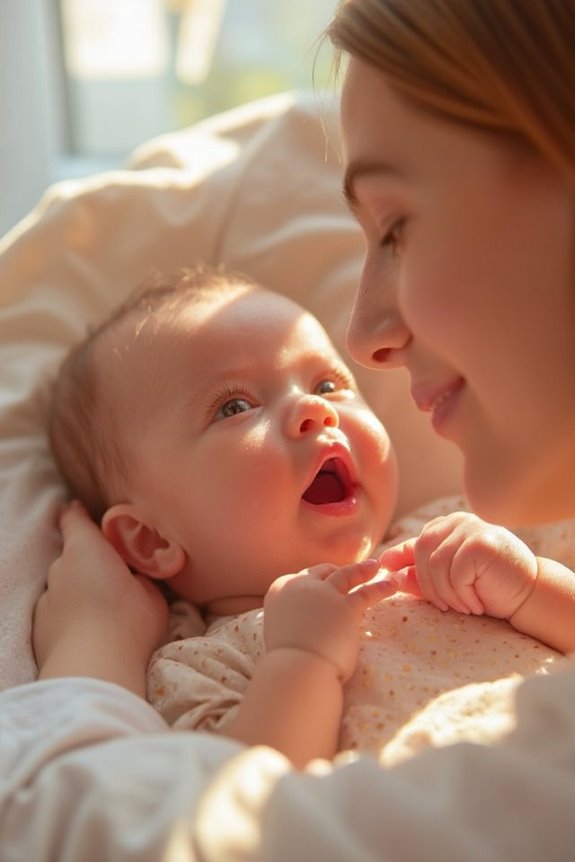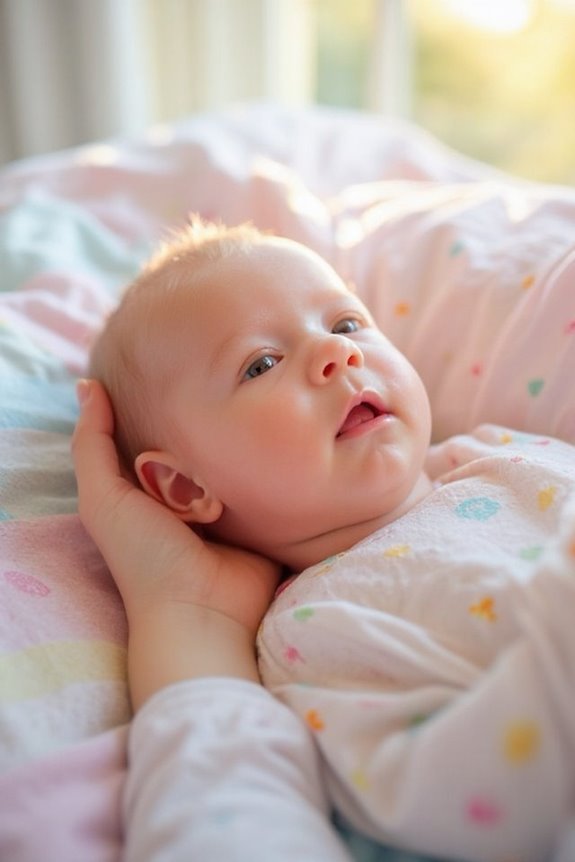Babies actually smile from birth, but these first smiles are reflexive, often occurring during sleep or randomly. True social smiles—responses to your face or voice—typically emerge between 6-8 weeks of age. This meaningful milestone signals healthy neurological development and emerging social awareness. I recommend face-to-face interaction, animated expressions, and games like peek-a-boo to encourage smiling. If your baby hasn’t shown social smiles by 3 months, consider consulting your pediatrician. The details below will help you distinguish these important developmental stages.
Key Takeaways
- Babies may display reflex smiles from birth, even during sleep, but these aren’t social responses.
- True social smiles typically emerge between 6-8 weeks of age as a response to external stimuli.
- By 2-3 months, most babies develop consistent social smiling, indicating proper neurological development.
- Caregivers can encourage smiling through face-to-face interaction, animated expressions, and responsive play.
- Consult a pediatrician if your baby hasn’t shown social smiles by 3 months of age.
The First Signs of Smiling in Babies
While babies are born with many natural reflexes, smiling is one of the most heartwarming developments parents enthusiastically await. I’ve observed that newborns can display their first smiles shortly after birth, but these are typically reflexive responses rather than social ones.
These early reflexes often occur:
- During sleep
- Without external stimuli
- In response to internal factors like gas
Reflex smiles generally disappear around 2 months after birth, replaced by true social smiles between 6-8 weeks of age. This change marks a significant milestone in your baby’s emotional development.
The emergence of social smiling indicates your baby is beginning to:
- Recognize familiar faces
- Respond to voices
- Interact with their environment
- Develop communication skills
Watch for these changes as they signal healthy neurological progression in your infant.
Distinguishing Between Reflex and Social Smiles
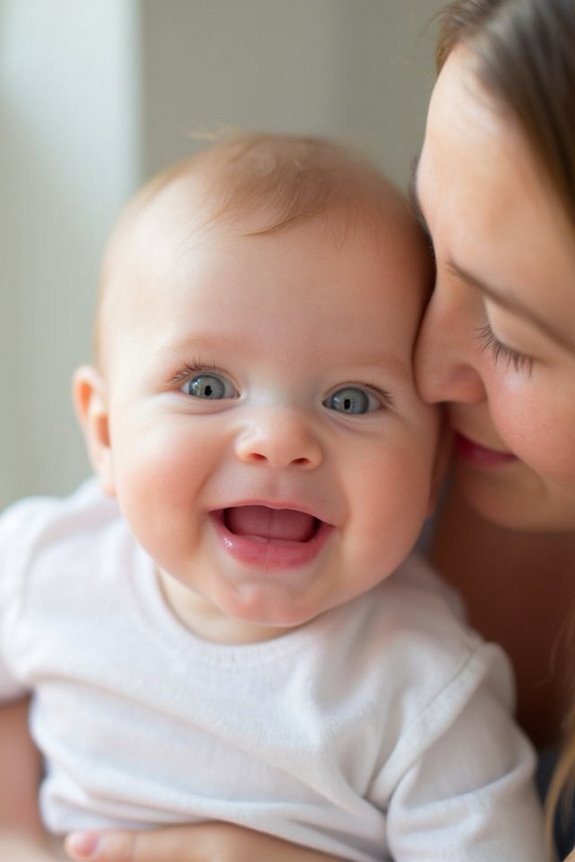
Although both types of smiles may look similar at first glance, reflex and social smiles represent fundamentally different developmental processes in your baby.
Reflex Smile Characteristics:
- Occurs as early as in the womb
- Happens randomly, not in response to external stimuli
- Part of neural development, not communication
Social Smile Characteristics:
- Typically emerges between 6-12 weeks
- Intentionally responds to your face or voice
- Serves as a form of communication and bonding
The key difference lies in purpose and timing. While reflex smiles are involuntary muscle movements, social smiles indicate your baby is developing important interaction skills. By 12 weeks, most infants consistently display social smiles, creating a rewarding feedback loop that strengthens your relationship.
How to Encourage Your Baby’s First Smile

Now that you can recognize the difference between reflex and social smiles, you’ll want to create opportunities for those meaningful first social smiles.
I recommend these evidence-based approaches:
- Face-to-Face Interaction: Maintain eye contact and display animated expressions to encourage baby communication.
- Interactive Play: Games like peek-a-boo stimulate your baby’s senses and often trigger smiles.
- Mirror Time: Show your baby their reflection to spark curiosity and facial responses.
- Sensory Engagement: Use soft sounds, music, and colorful toys to create a positive atmosphere.
- Consistent Response: When your baby does smile, respond enthusiastically to reinforce this behavior.
Remember that patience is essential. By combining regular cuddles, cheerful talking, and responsive interactions, you’ll create an environment where your baby feels secure enough to share those precious smiles.
Smiling as a Developmental Milestone

Smiles represent one of the most significant early developmental milestones in your baby’s life. When your baby begins to smile socially around 2-3 months, it signals proper neurological and sensory development.
The smiling significance extends beyond just being cute—it indicates:
- Your baby’s vision is developing, allowing them to focus on faces
- Their nervous system is maturing appropriately
- They’re beginning to integrate sensory information
- Early social cognition is emerging
Emotional bonding is enhanced through these early smiles, strengthening the connection between you and your infant. While reflexive smiles occur from birth, true social smiles by 6-8 weeks show your baby is developing on track.
Remember that premature babies may reach this milestone later, and individual differences are normal in healthy development.
When to Consult Your Pediatrician About Smiling

While most babies begin smiling socially between 6-12 weeks, you’ll want to monitor this important milestone and know when professional guidance might be needed.
Concerns Checklist
Consider a pediatric evaluation if:
- Your baby hasn’t smiled socially by 3 months
- Your child avoids eye contact during interactions
- A previously smiling baby stops smiling
- You notice any loss of recently acquired skills
- Your baby doesn’t engage with caregivers through smiling
Remember that babies develop at different rates, but these signs warrant discussion with your doctor. Regular check-ups (at least six times before age one) allow your pediatrician to assess developmental progress and recommend early interventions if needed.
Don’t hesitate to raise concerns—early identification of developmental issues leads to more effective support.
Frequently Asked Questions
Do Premature Babies Smile Later Than Full-Term Babies?
About 70% of premature infants achieve developmental milestones later than full-term babies. Yes, I’d say they typically smile later, but I measure from their corrected age (around 2 months), not chronological age.
Can Blind Babies Develop Social Smiles?
Yes, I’ve found that blind infants absolutely develop social smiles! They respond to auditory and tactile cues rather than visual ones, demonstrating that social development proceeds through alternative pathways even without visual feedback.
Do Babies Smile More at Certain Family Members?
Yes, babies often smile more at family members they recognize emotionally. I’ve noticed this connection strengthens family bonding, as babies develop preferences for those they interact with most frequently and feel secure around.
How Do Cultural Differences Affect Baby Smiling Patterns?
I’ve found that cultural norms considerably shape babies’ smiling patterns. While the milestone timing remains universal, how often babies smile and in what contexts is influenced by cultural approaches to emotional expression and face-to-face interaction.
Can Excessive Smiling Indicate a Neurological Condition?
Yes, I’ve seen excessive smiling potentially indicate conditions like Angelman Syndrome. While smiling milestones vary, persistent inappropriate smiling should prompt neurological assessments to identify underlying conditions requiring specialized support and intervention.
References
https://www.medicalnewstoday.com/articles/when-do-babies-start-smiling
https://health.clevelandclinic.org/when-do-babies-start-laughing-smiling
https://www.whattoexpect.com/first-year/first-smile/
https://www.healthychildren.org/English/tips-tools/ask-the-pediatrician/Pages/When-do-babies-first-smile.aspx
https://www.childresearch.net/aboutCS/mediscience/31.html
https://www.parents.com/baby/development/laughing/when-do-babies-start-smiling/
https://pathways.org/when-will-my-baby-smile
https://www.innovativeinterventionsnj.com/post/when-do-infants-smile-for-the-first-time
https://raisingchildren.net.au/babies/connecting-communicating/bonding/whats-in-a-smile
https://today.ucsd.edu/story/babies_time_their_smiles_to_make_their_moms_smile_in_return

